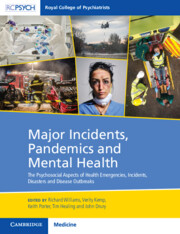 Major Incidents, Pandemics and Mental Health
Major Incidents, Pandemics and Mental Health Book contents
- Major Incidents, Pandemics and Mental Health
- Major Incidents, Pandemics and Mental Health
- Copyright page
- Dedication
- Contents
- Figures
- Tables
- Boxes
- Contributors
- Foreword by Dr Adrian James
- Foreword by Professor David Lockey
- Section 1 The Nature and Impacts of Twenty-First-Century Healthcare Emergencies
- Section 2 Clinical Aspects of Traumatic Injuries, Epidemics, and Pandemics
- Section 3 The Role of the Public in Emergencies: Survivors, Bystanders, and Volunteers
- Chapter 19 The Role of the Public: Understanding Group Processes in Emergencies, Incidents, Disasters, and Disease Outbreaks
- Chapter 20 Social Identity and Traumatic Stress in the Context of an Earthquake and a Pandemic
- Chapter 21 Mobilisation and Deterioration of Social Support Following Disasters Resulting from Natural and Human-Induced Hazards
- Chapter 22 Collective Responses to Terrorist Attacks
- Chapter 23 Collective Psychosocial Resilience as a Group Process Following Flooding
- Chapter 24 Facilitating the Public Response to COVID-19
- Chapter 25 The Social Psychology of Mass Casualty Decontamination in Chemical, Biological, Radiological, or Nuclear (CBRN) Incidents
- Chapter 26 Factors That Determine Wider Solidarity Responses After a Major Incident or Disaster
- Section 4 Responses to Meet the Mental Health Needs of People Affected by Emergencies, Major Incidents, and Pandemics
- Section 5 Sustaining and Caring for Staff During Emergencies
- Section 6 Designing, Leading, and Managing Responses to Emergencies and Pandemics
- Section 7 Key Lessons for the Way Forward
- A Glossary of Selected Key Terms Used in This Book
- Index
- References
Chapter 20 - Social Identity and Traumatic Stress in the Context of an Earthquake and a Pandemic
Understanding the Roles of Shared and Isolating Social Experiences
from Section 3 - The Role of the Public in Emergencies: Survivors, Bystanders, and Volunteers
Published online by Cambridge University Press: 11 January 2024
- Major Incidents, Pandemics and Mental Health
- Major Incidents, Pandemics and Mental Health
- Copyright page
- Dedication
- Contents
- Figures
- Tables
- Boxes
- Contributors
- Foreword by Dr Adrian James
- Foreword by Professor David Lockey
- Section 1 The Nature and Impacts of Twenty-First-Century Healthcare Emergencies
- Section 2 Clinical Aspects of Traumatic Injuries, Epidemics, and Pandemics
- Section 3 The Role of the Public in Emergencies: Survivors, Bystanders, and Volunteers
- Chapter 19 The Role of the Public: Understanding Group Processes in Emergencies, Incidents, Disasters, and Disease Outbreaks
- Chapter 20 Social Identity and Traumatic Stress in the Context of an Earthquake and a Pandemic
- Chapter 21 Mobilisation and Deterioration of Social Support Following Disasters Resulting from Natural and Human-Induced Hazards
- Chapter 22 Collective Responses to Terrorist Attacks
- Chapter 23 Collective Psychosocial Resilience as a Group Process Following Flooding
- Chapter 24 Facilitating the Public Response to COVID-19
- Chapter 25 The Social Psychology of Mass Casualty Decontamination in Chemical, Biological, Radiological, or Nuclear (CBRN) Incidents
- Chapter 26 Factors That Determine Wider Solidarity Responses After a Major Incident or Disaster
- Section 4 Responses to Meet the Mental Health Needs of People Affected by Emergencies, Major Incidents, and Pandemics
- Section 5 Sustaining and Caring for Staff During Emergencies
- Section 6 Designing, Leading, and Managing Responses to Emergencies and Pandemics
- Section 7 Key Lessons for the Way Forward
- A Glossary of Selected Key Terms Used in This Book
- Index
- References
Summary
A social identity explanation is used to offer insight into who is and who is not affected by trauma, using two examples from data collected after an earthquake in Nepal in 2015 and during the COVID-19 pandemic in 2020. Traumatic experience is not equally distributed across any population, and the likelihood of experiencing an extreme event is affected by group membership and particularly the status of different groups. Attributes of groups and the resources that they offer to members can be important in driving risk and resilience. The chapter offers evidence that trauma and social identities are inherently linked, and that changes in our social identity resources have substantial consequences for health and wellbeing. Derived from this approach, we can recognise those people who are likely to have short-term versus long-term impacts as a consequence of traumatic experiences. Finally, the chapter discusses how this work can inform policy and practice.
Keywords
- Type
- Chapter
- Information
- Major Incidents, Pandemics and Mental HealthThe Psychosocial Aspects of Health Emergencies, Incidents, Disasters and Disease Outbreaks, pp. 141 - 146Publisher: Cambridge University PressPrint publication year: 2024
